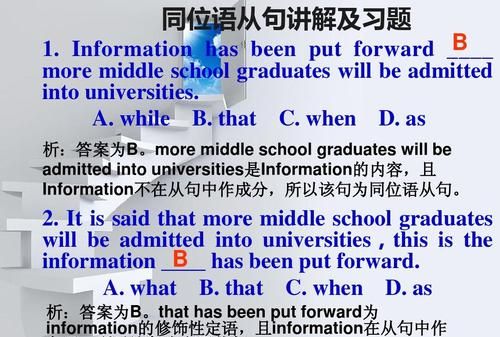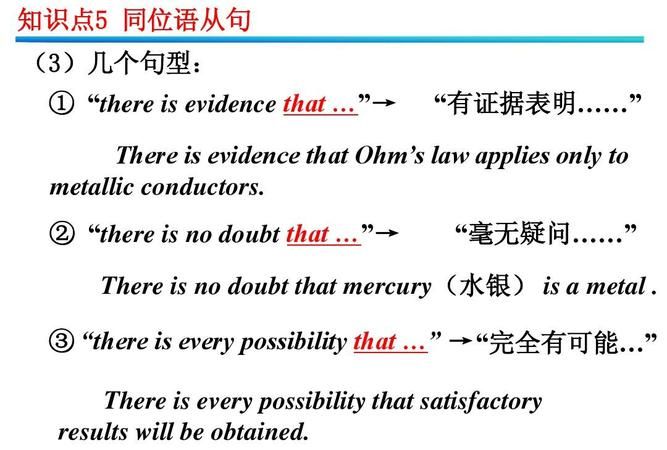本文目录
英语与中文的区别举例说明
英语同位语举例说明如下:
1、She hasn't made the decision whether she should give up。 她还没决定她是否应当放弃。
2、I have no idea what has happened to him。 我不明白他发生了什么事。

3、There was no doubt that he is honest man。 毫无疑问他是诚实的人。
4、You have no idea how worried I was。 你不明白我当时有多担忧。
5、I have no idea why he resigned。 我不明白他为何辞职。
6、They were worried over the fact that you were sick. 他们为你生病发愁。
7、The news that we are having a ho1 iday tomorrow is not true.明天放假的消息不实。

8、We are not investigating the question whether he is trus tworthy.我们不是在调查他是否可以信任的问题。
9、Answer my question whether you are coming. 你回答我的问题:你来不来。
10、 Have you any idea what time it starts?你知道什么时候开始吗?
英语中的同位语是什么
同位语
一个名词(或其它形式)对另一个名词或代词进行修饰,限定或说明,这个名词(或其它形式)就是同位语。同位语与被它限定的词的格要一致,并常常紧挨在一起。

英语学习:什么是同位语
同位语就是两个名词性的短语或从句表述同一样东西,我举个同位语从句的例子吧:
The that the sun moves around the earth is wrong.
这里that the sun moves around the earth 就是 idea的同位语。
实际上同位语从句的先行词往往是idea, opinion这类的词,但有一点需要注意的是,这类词后面的that从句并不都是同位语从句,比如
The idea that I thought out this morning was proved right.
这里的从句that I thought out是个定语从句。区别就在于定语从句是不完整的(本句里就是个没宾语的从句)而同位语从句是完整的(就像上一个例子里的the sun moves around the earth)。能理解了吗?

在英语里什么是同位语
同位语,代表一个名词(或 其它 形式)对另一个名词或代词进行修饰,限定或说明。同位语与被它限定的词的格要一致,并常常紧挨在一起。
例句
⒈由两个或两个以上同一层次的语言单位组成的结构,其中前项与后项所指相同,句法功能也相同,后项是前项的同位语。
Mr. Smith,our new teacher,is very kind to us.
我们的新老师史密斯先生对我们很好。
our new teacher是主词Mr. Smith的同位语,指同一人。
Yesterday I met Tom,a friend of my brother's.
昨天我遇到了我弟弟的朋友汤姆。
a friend of my brother's是受词Tom的同位语,指同一人。
⒉如同位语与其同位成分关系紧密时不用逗点隔开;如同位语对其同位成分只作补充解释时可用逗点隔开。
He himself told me that his brother John is a world-famous doctor.
他本人对我讲,他的兄长约翰是一位世界闻名的医生。
himself和John都是单一的字作同位语,与其同位成分之间不用逗点隔开。
Yesterday I talked to my English teacher,Mr. James.
昨天我与我的英语老师詹姆斯先生谈过了。
同位语Mr. James补充解释my English teacher,同位语与其同位成分之间可用逗点隔开。
⒊同位语除表示其同位成分的全部意义外,还可以表示部分意义。
We Chinese people are brave and hardworking.
我们中国人民是勤劳勇敢的。
He is interested in sports,especially ball games.
他喜欢运动,特别是 球类运动 。
同位从句一般跟在某些名词如answer(答案),hope(希望),fact(事实),belief (信 仰),news(消息),idea(主意;观念),promise(承诺),information(信息),conclusion(结论),order(命令), suggestion(建议),problem(问题),thought (想法)等后面。例如:He always works hard even if he knows the fact that he is not in good health. His failure was due to the fact that he had not practised for a long time. I had no idea that you were here. She told us her hope that she would become a pianist. He made a promise that he would never come late. 注意:that 既可引导同位语从句又可引导定语从句,其区别在于:同位语从句由连接词that引导,连接词that本身无意义,在同位语从句中不充当任何成分,不可省略,不可以用其他词替代;定语从句由关系代词that引导,关系代词that在从句中充当一定的成分,作宾语时可省略,由when,why,where引导的 同位语从句和定语从句的区别在于:同位语从句由连接副词只起连接作用,没有指代作用; 定语从句由关系副词引导,关系副词具有指代先行词的作用,常用一个介词加关系代词替换。例如:I will never forget the day when we first met. (定语从句,when关系副词) That is the special day (which/that) I will never forget. (定语从句,which/that为关系代词) This is the house where we lived fifteen years ago. (定语从句,where为关系副词) This is the house which we sold fifteen years ago. (定语从句,which为关系代词)

以上就是关于英语同位语是什么举例,英语与中文的区别举例说明的全部内容,以及英语同位语是什么举例 的相关内容,希望能够帮到您。

